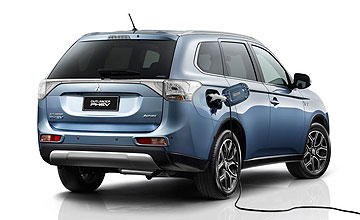BY MIKE COSTELLO | 17th Nov 2014

Did we mention we are sitting at the wheel of a compact SUV with five normal-sized seats that costs about the same as its diesel stable-mate, and $12,000 less than the four-seat Holden Volt?Mitsubishi has at last launched its Outlander PHEV, after being delayed repeatedly by — first — a global recall due to dodgy third-party batteries, and then heavy demand from Europe.
It will serve as a much-needed halo car for the Japanese manufacturer, a timely reminder that the company is more than a purveyor of sharply-priced utes and small-cars.
And used in the context mentioned in the opening lines of this story, the PHEV is a rather enticing option. But before we explain the ‘why’, let’s look at the ‘how’.
A 2.0-litre petrol engine at the front is hooked up to a generator linked to a lithium-ion battery pack in the floor. In addition, electric motors sit next to both axles.
Unlike a conventional hybrid such as a Prius or Camry, the battery can be charged by either the petrol engine or a wall socket (in about five hours).
Unlike a pure EV like a Nissan Leaf, there is no range anxiety, because when the cells die, the engine acts as a recharger.
There is a single-speed transmission channeling the power. The extant paddle-shifters on the wheel add or subtract regenerative braking, meaning they act as level-one stoppers that come in handy on freeways and when slowing down for corners. It is also much more energy-efficient than using the brake pedal in city driving.
Mitsubishi claims you can drive upwards of 50km on electric power alone, unless you’re travelling at highway speeds, at which time the engine will fire up and send power to the front axle to supplement the motors in shifting the PHEV’s 1800kg-plus dry weight.
This means that if you, like the majority of compact SUV drivers, typically use the car for inner-city work trips or school runs, you could quite feasibly never see a fuel bowser. Just plug the car into the wall and cop a household electricity increase, albeit one far cheaper than petrol.
Somewhere between $3.00 and $3.50 per recharge should about cover it.
The claimed 1.9L/100km fuel consumption figure (and 44g/km CO2 emissions) takes into account the petrol used at (a) high speed driving when the engine is needed to supplement the motors and (b) be inclusive of times when the battery cells are depleted.
However, there is a catch. Because if you drive, say, 100km on country roads, at least 50 of the kilometres will be using petrol power only. And no atmo 2.0-litre petrol engine lugging about almost 2-tonnes (passenger included) is going to be a fuel-sipper, since it has to work rather hard.
Over 150km at 100km/h, we used 6.7L/100km, inclusive of the 50km of almost emissions-free driving. Which is still excellent for an SUV. But we’ll bet we could do better with a diesel. And here is where the PHEV makes less sense.
It is rather telling, however, that the PHEV makes sense in any way at all.
Mitsubishi said all along it wanted to price the car at a reasonable level, and it has. Starting at $47,490, it is no more expensive than a diesel SUV in its class, and scarcely less well-equipped.
Compare this to the smaller (but much more ‘interesting’ looking) $59,990 Holden Volt, and the value equation is very strong indeed. And we bet a few early adopters and green-minded fleets will be taking a long, hard look on this basis.
Beyond the drivetrain and the big ‘PHEV’ badge on the quarter panel, the Outlander is just like a regular SUV, albeit one with a restricted amount of cargo space thanks to the higher floor — there’s still room for an Ikea cabinet, though — and no spare wheel.
With a weight distribution of 55:45, there is some decent balance mid-corner.
The electric steering is light but progressive, too. Road noise from the Toyo tyres is a little high, though around town it is less noticeable.
We timed the zero to 100km/h sprint at a touch over 10 seconds, which certainly isn’t swift. But the electric motors give lots of low-down torque, so take-offs from lights in the city are swift enough. The PHEV also cruises along happily enough at 110km/h.
Finally, we took in some rough dirt paths and even a little mild rock-hopping, and found no issues. The underbody is protected and the ground clearance is unaffected. Mitsubishi says you can even do water crossings without frying any fish with the electric drivetrain.
The airy cabin is logical if a little dull. The screen with nifty ECO diagrams and illustrations showing you how much juice you’re using is nifty, as well.
Like all Mitsubishis, the PHEV gets a five-year/100,000km warranty. It also qualifies for Mitsubishi’s four-year capped-price servicing, which is $360 for the first service and $470 for the second, third and fourth services, scheduled every 15,000km or 12 months.
So then, how do we rate the PHEV? We applaud, firstly, the bold pricing. And the urban fuel consumption is outstanding.
If you’re an urban-dweller and want to be on the cutting edge of the green movement, head in for a drive. But if you take regular trips to the country, maybe crunch the numbers on that diesel variant.